Stop rushing through decluttering and avoid overloading trash bins or tackling the entire room at once. Instead, adopt a methodical approach by breaking the space into sections, sorting items carefully, and creating designated spots for everything. Don’t keep things just in case or ignore hidden clutter. Focus on making decisive choices, establishing sustainable habits, and following up regularly. If you stay patient, you’ll discover proven strategies that make decluttering more effective and less overwhelming.
Key Takeaways
- Stop dumping everything into one trash bin; instead, sort items into recyclables, donations, and trash to maintain clarity.
- Avoid temporary solutions like quick fixes; develop sustainable habits such as daily tidying routines.
- Do not overlook hidden clutter; regularly check behind furniture, inside drawers, and on high shelves.
- Refrain from emotional attachment avoidance; confront feelings and make decisive choices about what to keep or discard.
- Stop relying solely on short-term organization; implement long-term systems, regular maintenance, and visual cues for ongoing order.
Stop Overloading Trash Bins and Start Sorting Items
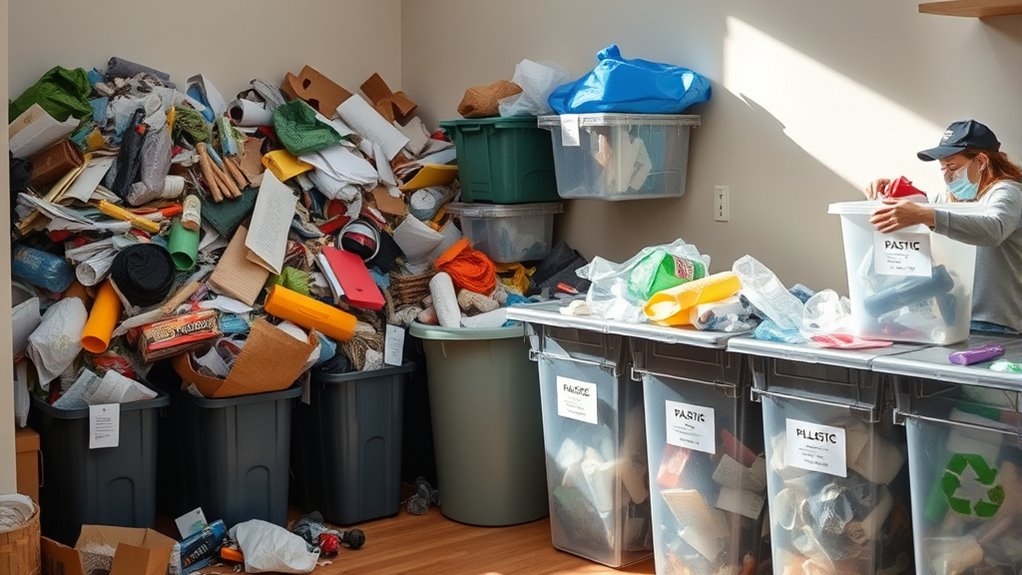
To keep your space organized, it’s important to stop overloading trash bins and start sorting items instead. Trash overload can make it tempting to toss everything into one bin, but this approach hinders effective decluttering. Instead, adopt sorting strategies that separate recyclables, trash, and items to donate or keep. By sorting as you go, you prevent bins from overflowing and create a clearer picture of what truly needs disposal. Use multiple containers or designated areas to categorize your waste and belongings. This method reduces clutter, speeds up the cleanup process, and ensures you don’t accidentally throw away something valuable. Remember, a well-organized space begins with disciplined sorting, not just dumping everything into the nearest trash bin. Incorporating vertical storage solutions can further optimize space and keep items neatly separated.
Stop Rushing Through the Process and Embrace a Methodical Approach
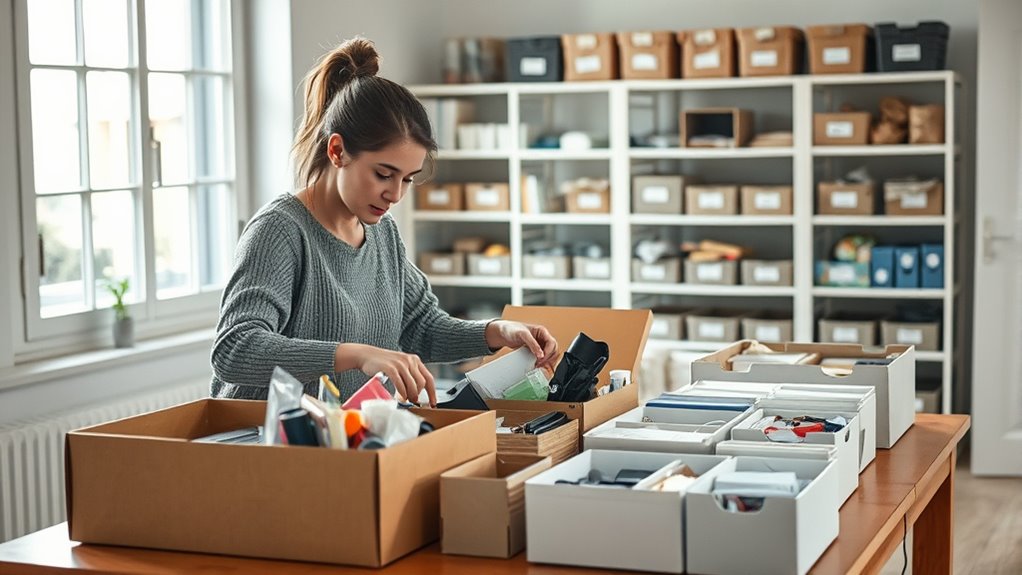
Rushing through decluttering can lead to missed spots and frustration. Instead, set clear goals for each session and focus on small sections at a time. This methodical approach keeps you organized and makes the process feel more manageable. Incorporating a structured plan can enhance efficiency and reduce overwhelm during the decluttering process.
Set Clear Goals
Instead of rushing through your decluttering project, take the time to set clear, specific goals. Knowing what you want to achieve helps guide your efforts and keeps you focused. Think about what storage solutions you need and how each area will function once decluttered. For example, your goal might be to create a dedicated space for work supplies or to clear out unused items. Effective goal setting allows you to break down the process into manageable steps, preventing overwhelm. Be precise about what you want to accomplish in each section of the room. Clear goals give you direction, making the decluttering more efficient and satisfying. Remember, having a target in mind keeps you motivated and ensures your efforts lead to a more organized space. Incorporating a methodical approach can help you stay consistent and achieve lasting results.
Tackle Small Sections
Once you’ve set clear goals for your decluttering project, it’s time to break the task into smaller, manageable sections. Focus on one area at a time to avoid feeling overwhelmed. Tackle small sections like a drawer, shelf, or corner—this keeps you motivated and makes progress tangible. Use storage solutions and organizational systems to streamline each section, making it easier to maintain. Visualize each step:
- Clearing out a single drawer or shelf
- Sorting items into keep, donate, or discard
- Applying storage solutions for better organization
- Labeling containers for easy access
- Reassessing each section before moving on
Focusing on small sections prevents rushing and helps you create a clutter-free space efficiently. This methodical approach ensures lasting results without burnout. Incorporating organization techniques such as color coding and modular storage can further enhance your decluttering efforts.
Stop Keeping Items Just Because They Might Be Useful One Day
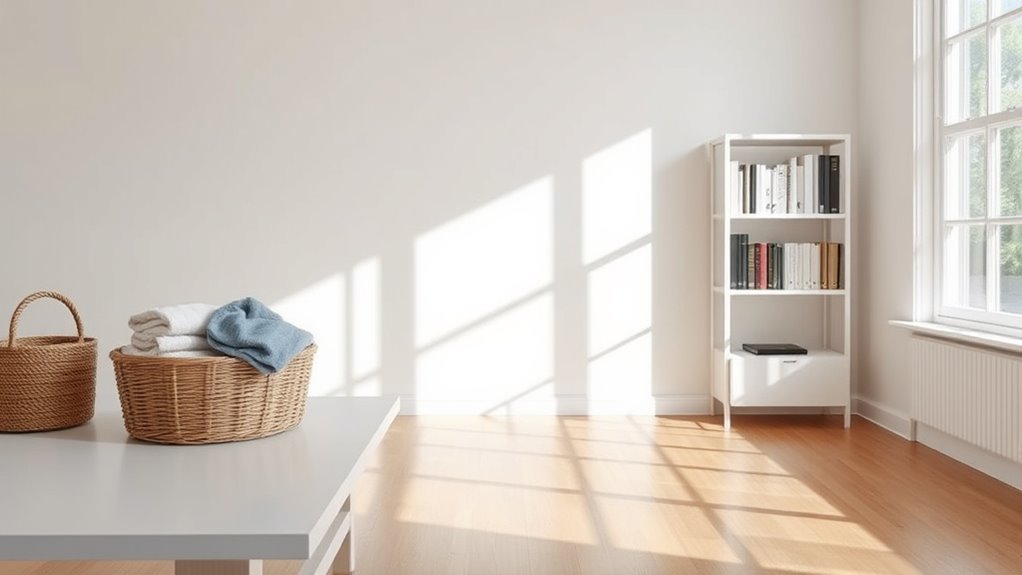
Holding onto items just in case they might be useful someday often leads to clutter and unnecessary stress. These items may serve as memory triggers or hold sentimental value, but they rarely get used. Ask yourself if you genuinely need the item or if it’s just taking up space. Consider this table:
| Item Type | Why Keep? |
|---|---|
| Old clothes | Sentimental memories |
| Broken tools | Might fix someday |
| Empty jars | Future storage |
| Unused gadgets | Might find a use |
| Childhood memorabilia | Nostalgia or sentimental value |
If the item doesn’t serve a current purpose or evoke strong memories, it’s time to let it go. Focus on what truly matters, not what might be useful “one day.”
Stop Ignoring Hidden Clutter and Focus on Every Corner
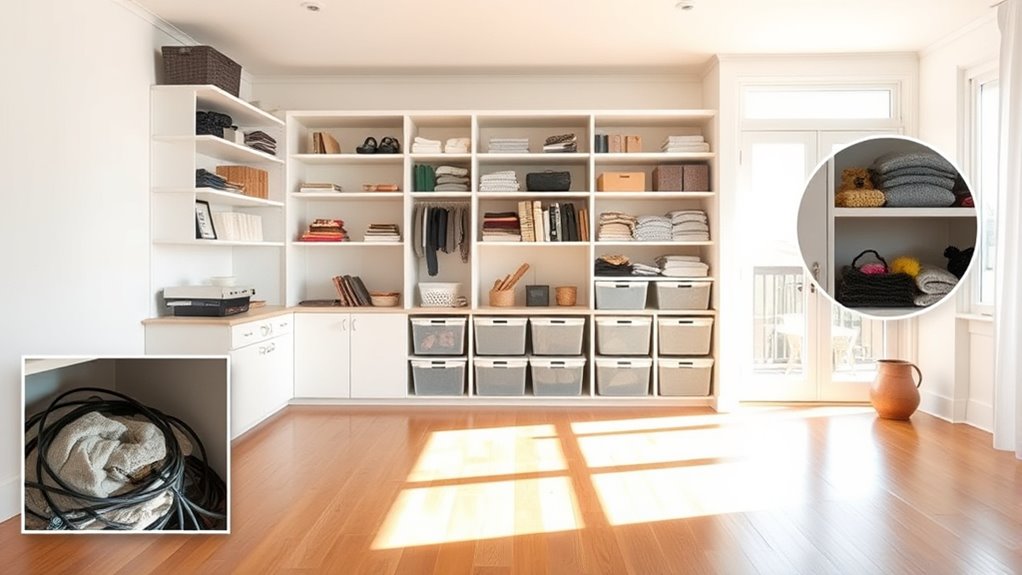
You might be surprised by clutter hiding in unexpected places, so it’s time to check every corner. Scan behind furniture, inside drawers, and on high shelves to uncover overlooked messes. Tackling those hidden spots makes a real difference in creating a truly tidy space. Consider paying special attention to natural materials and vintage decor items that can accumulate dust or clutter over time.
Scan All Hidden Spaces
Hidden spaces often trap clutter that we overlook during routine tidying, making it harder to achieve a truly organized room. To combat this, you need to scan all hidden spaces and concealed areas thoroughly. These spots include beneath furniture, inside cabinets, behind doors, in closet corners, and under sinks. By actively searching these zones, you prevent clutter from hiding out of sight, which can quickly accumulate. Make sure to check:
- Under bed frames and furniture
- Inside seldom-used drawers
- Behind or inside appliances
- Behind or above cabinets
- In storage bins tucked away
Focusing on these concealed areas reveals clutter that hampers your organization efforts. Incorporating effective decluttering strategies into your routine can help maintain a consistently tidy space. Clearing these spaces ensures a more extensive decluttering process, creating a cleaner, more functional room.
Tackle Overlooked Areas
Since overlooked areas often become the most cluttered spots in a room, it’s essential to give these corners and nooks your full attention. Use effective storage solutions and organization techniques to reveal hidden space. Check behind furniture, inside closets, and under sinks for clutter buildup. These spots can hide items you no longer need, making cleaning more efficient. To optimize your efforts, consider labeling storage bins and using vertical space for better organization. Keep a list of overlooked areas to systematically address each one. By tackling these neglected spots, you prevent clutter from accumulating unnoticed, creating a cleaner, more functional room. Remember, Vetted organization strategies make your decluttering efforts sustainable and rewarding.
Stop Using Trash Bags as Storage and Create Designated Spaces
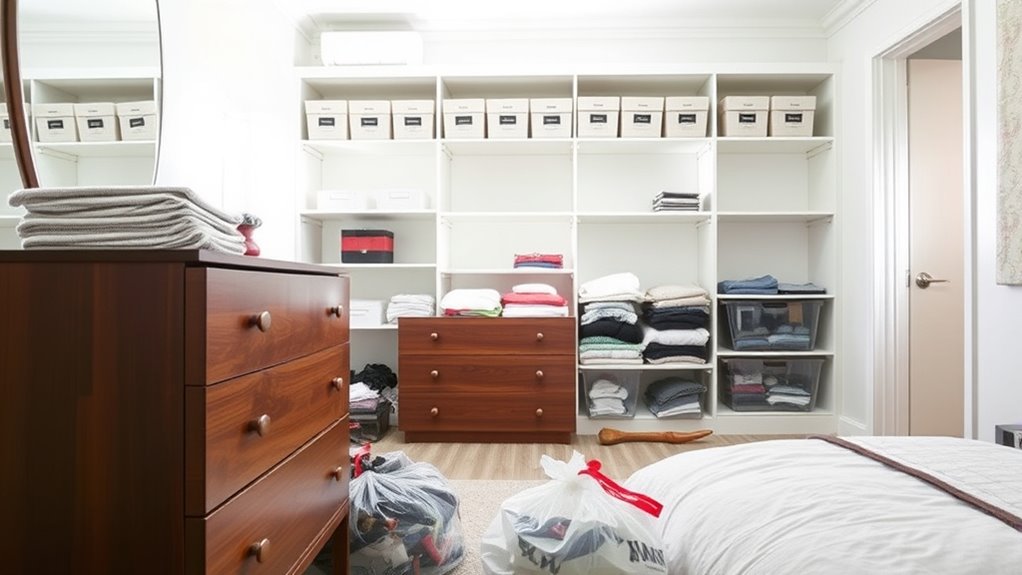
Using trash bags for storage might seem convenient, but it often leads to chaos and difficulty finding items later. Instead, invest in proper storage solutions and organization systems. These help create clear, designated spaces for everything, making your room easier to maintain. Visualize having:
- Labeled bins for different categories
- Shelving units for accessible storage
- Drawer dividers to separate small items
- Stackable containers for maximizing space
- Hooks or wall-mounted racks for added organization
Focusing on the organization system can significantly improve your ability to keep your space tidy and functional over time.
Stop Tackling the Whole Room at Once and Break It Into Sections
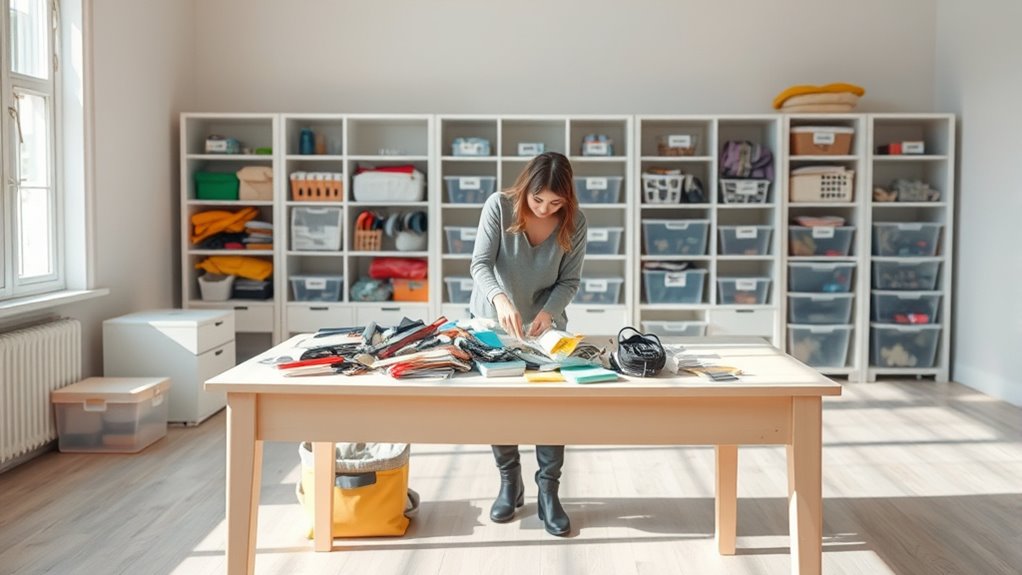
Trying to clean the entire room at once can feel overwhelming and often leads to frustration or burnout. Instead, break the space into manageable sections through room zoning. Focus on one zone at a time, like a corner or a specific area, to stay organized and motivated. Pay special attention to clutter hotspots—areas where clutter tends to pile up quickly. By dividing your room into sections, you can target these hotspots directly, making progress without feeling overwhelmed. This approach helps you see quick wins, keeps your energy up, and prevents burnout. Remember, tackling smaller sections allows you to maintain focus and develop better habits for ongoing decluttering. Incorporating a methodical approach to your cleaning can further improve efficiency and consistency. Over time, your space will become more organized and easier to manage.
Stop Ignoring the Emotional Attachments and Make Decisive Choices

Emotional attachments can make it difficult to let go of certain items, but avoiding these feelings only prolongs clutter and prevents progress. Developing emotional awareness helps you recognize why you hold onto things, making it easier to make decisive choices. When you confront these feelings, you can evaluate whether an item truly adds value or nostalgia. Visualize items like:
- Old keepsakes tied to memories
- Gifts with sentimental significance
- Clothes worn only once
- Mementos from past experiences
- Items inherited from loved ones
Understanding your interpersonal communication styles can also assist in processing emotional attachments, making it easier to detach from items that no longer serve you.
Stop Relying on Temporary Solutions and Establish Sustainable Habits
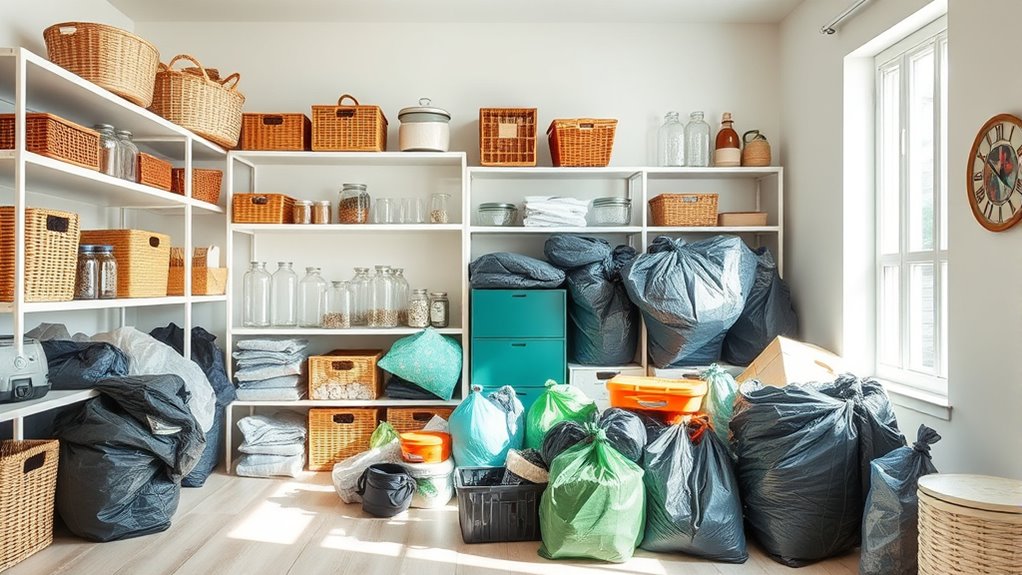
Temporary fixes might provide quick relief, but they rarely lead to lasting order. Relying on these short-term solutions can cause clutter to resurface quickly. Instead, focus on habit formation to create sustainable routines that keep your space organized long-term. Establish clear, manageable daily or weekly habits, like spending five minutes each evening tidying up or sorting mail immediately. Consistency is key—by integrating these habits into your routine, decluttering becomes second nature. Avoid the trap of temporary solutions that only mask the problem. Instead, build habits that support ongoing organization, making your space easier to maintain and less prone to chaos. Incorporating habit formation strategies can enhance your ability to sustain these routines over time. Over time, these sustainable routines will transform your environment into a tidy, functional space that doesn’t require constant fixing.
Stop Forgetting to Maintain and Follow Up on Your Decluttering Efforts
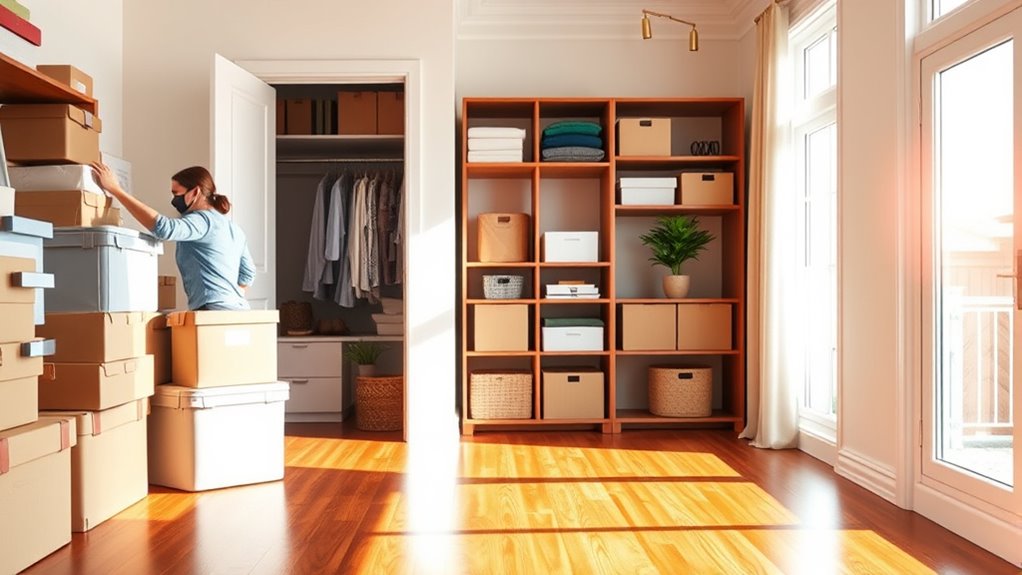
To keep your space truly organized, it’s essential to regularly maintain and follow up on your decluttering efforts. Without consistent maintenance routines, clutter can quickly reappear. Establish clear follow-up strategies, such as weekly check-ins or monthly tidy-ups, to stay on top of your organization. Think about creating designated spots for items, setting reminders, or scheduling quick decluttering sessions. Visualize your space with:
- A weekly 10-minute tidy-up
- Checklists to track what needs attention
- Reminders on your phone or calendar
- Reassessing storage solutions quarterly
- Celebrating small wins to stay motivated
These simple steps help prevent clutter from creeping back and ensure your efforts stick. Regular follow-up strategies keep your space functional and your mindset focused on maintaining order long-term. Incorporating professional voiceover techniques into your routines can also make the process more engaging and enjoyable.
Frequently Asked Questions
How Can I Stay Motivated During a Long Decluttering Session?
To stay motivated during a long decluttering session, use motivational strategies like setting small, achievable goals and rewarding yourself afterward. Break the task into manageable chunks, and track your progress to see how much you’ve accomplished. Remember your end goal, whether it’s a tidy space or a fresh start, and keep that in mind. Staying focused on your purpose helps maintain momentum and makes the process less overwhelming.
What Are the Best Tools for Effective Room Decluttering?
You should use durable storage containers to organize your belongings and keep things tidy. Clear containers help you see what’s inside, making decluttering easier. Don’t forget to have cleaning supplies handy—like sprays and cloths—to quickly clean surfaces as you go. These tools keep your space organized and fresh, making the decluttering process more effective and less overwhelming. With the right tools, you’ll finish faster and enjoy your clean room more.
How Do I Handle Sentimental Items I Want to Keep?
You find a sentimental item and realize it’s more than just clutter. To handle sentimental attachment, set aside a special box for keepsake preservation, limiting yourself to a few meaningful items. Consider photographing or journaling stories behind each keepsake. This way, you honor your memories without overwhelming your space. You’ll feel lighter and more intentional, knowing you’re preserving what truly matters while decluttering the rest.
When Should I Consider Donating Versus Discarding Items?
You should consider donating items that meet donation criteria, like being in good condition and still useful, rather than discarding them. Use discarding guidelines to decide when an item is no longer functional or necessary. If an item no longer serves a purpose or can’t be donated, it’s time to discard it. Prioritize donating items that can help others, and only discard what’s truly beyond reuse or donation.
How Often Should I Repeat the Decluttering Process to Maintain Order?
You should declutter as often as it takes to keep your space from turning into a chaotic tornado. Typically, a regular schedule of weekly or monthly tidying helps maintain order, but don’t forget seasonal decluttering—once every few months—to tackle accumulated clutter. Consistency is key; create a routine that works for you, and over time, your space remains calm and organized without feeling like an endless battle.
Conclusion
Think of decluttering like planting a garden—you can’t expect everything to flourish overnight. By embracing a steady, methodical approach, you create space for growth and clarity. Remember, even small, consistent efforts—like watering your plants—build momentum over time. Stay committed, break tasks into sections, and celebrate your progress. Before you know it, your space will bloom with order and peace, transforming chaos into a sanctuary you’ll love to be in.










